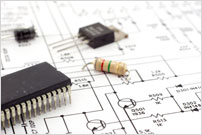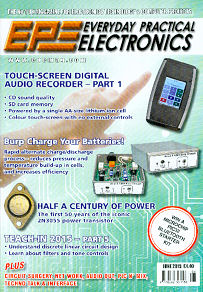June 2015 Issue
A summary of this month's contents.
Touch-Screen Digital Audio Recorder (Part 1)
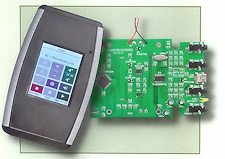 This compact, hand-held unit will record and play back audio with CD sound quality, supporting 16-bit stereo PCM-encoded files at sample rates of 8-96kHz.
This compact, hand-held unit will record and play back audio with CD sound quality, supporting 16-bit stereo PCM-encoded files at sample rates of 8-96kHz.
It records and plays standard .WAV audio and is compatible with any PC or Mac. This latest design uses a standard SD card and doubles as an SD card reader if connected to a PC using its USB interface.
 A 72mm TFT resistive-type touchscreen display forms the main control panel and a single USB-rechargeable AA-size Lithium-Ion cell offers constructors hours of service.
A 72mm TFT resistive-type touchscreen display forms the main control panel and a single USB-rechargeable AA-size Lithium-Ion cell offers constructors hours of service.
Principles of design are discussed this month with full constructional details being published in Part Two next month.
![]() Surface mount design needs good soldering skills
Surface mount design needs good soldering skills
“Burp-charge” your batteries
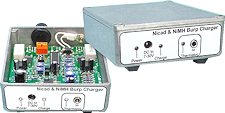
Burp-charging is a novel technique for recharging batteries that involves a rapid alternating charge / discharge process. This reduces gas pressure and temperature build-up in cells and increases the charging efficiency as well.
Our Burp Charger can charge a single cell or up to 15 series-connected Ni-Cd or NiMH cells. Maximum charge current 4.0A, top-up or trickle charge setting, temperature protection. PIC 16F88 microcontroller powered with free source code available from the EPE Library as usual.
This article also includes some very useful theory on burp-charging and its historical evolution since the early days of space flight.
![]() Surface mount design needs good soldering skills
Surface mount design needs good soldering skills
Half a Century of the 2N3055
 Celebrating 50 years of the world’s favourite power transistor, the 115W 2N3055 TO-3 silicon npn transistor provided the muscle in many constructional projects and is still present today in many a hobbyist’s spares bin as a general-purpose bulletproof power transistor.
Celebrating 50 years of the world’s favourite power transistor, the 115W 2N3055 TO-3 silicon npn transistor provided the muscle in many constructional projects and is still present today in many a hobbyist’s spares bin as a general-purpose bulletproof power transistor.
Although this elderly semiconductor is probably reaching the end of the road, eclipsed by more modern silicon manufacturing techniques, many experimenters still appreciate the contribution that the 2N3055 has made towards the evolution of electronic design and this interesting article traces its heritage back half a century.
Teach-In 2015 (Part 5)
Discrete Linear Circuit Design: Filters and tone controls

Our monthly tutorial series continues by introducing the use of filters to modify or compensate for the frequency response of an audio amplifier. Low pass and high pass filters and practical considerations are explained, helped by computer software simulations. We also look more deeply into the subject of Noise and how it can be measured or reduced. Our Teach-In tutors then describe a versatile tone control that can be used standalone or in conjunction with other Teach-In projects.
If you’re into analogue or audio electronics and want a deeper insight into how to harness filter networks, then this article will be essential reading!
 Please Take Note
Please Take Note
On page 42 third column under the heading ‘Signal to Noise Ratio’ the left-hand side of the first equation that reads “(S+N)/N=” should be simply “S/N=”. Thanks to reader Dave Reeves for pointing this out.
Interface
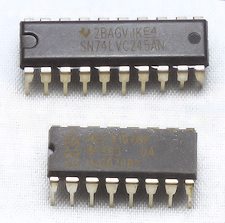
Our PC interfacing column discusses the principles of level shifting, the need to logic level voltages to make them compatible with other circuit specifications. Basic logic chip solutions are discussed.
Also in this month's issue:
- Audio Out – specially written for audio circuitry enthusiasts, this month continues with the theme of germanium transistors including a tear-down of the vintage Sinclair TR750 audio amplifier.
- Techno Talk – ridiculous EU restrictions on home-made projects; Squink printable PCBs
- Net Work – the Internet column explains why TLS is a wiser choice than SSL security; an insight into the real dangers posed by ransomware and Cryptowall.
- Circuit Surgery – our monthly ‘surgeon’ offers an intensive tutorial and talk-through of the parameters and characteristics of comparator hysteresis
- PIC n’ MIX – our PIC expert re-visits the challenge of using a 320 x 240 colour LCD and software modifications that can improve its sampling efficiency.
- Max’s Cool Beans Blog – more musings on the Arduino-powered electromechanical mayhem of the Vetinari Clock that the author promises is heading our way!
Next month: Threshold Voltage Switch – a useful general-purpose trigger circuit with a multitude of uses; L-o-o-o-ng Gating Times for the 12-Digit High Resolution Counter; Touch Screen Digital Audio Recorder (Part 2); Teach-In 2016 (Part 6) Power and Power measurement.
EPE is packed with practical electronics projects and theory for the hobbyist. You can order a printed copy of EPE for delivery to your door (worldwide), or try the PDF Version (needs Adobe Reader for Windows), or the Pocketmags for your mobile device. Subscribe now!
Source code file 0615.zip inc Teach-In 2015 update
 Teach-In 2015 (5) Please Take Note
Teach-In 2015 (5) Please Take Note
On page 42 third column under the heading ‘Signal to Noise Ratio’ the left-hand side of the first equation that reads “(S+N)/N=” should be simply “S/N=”. Thanks to reader Dave Reeves for pointing this out.
PCB artwork
As from July 2013 issue PCB artwork is available free to subscribers only.
Non-subscribers may purchase artwork files for a nominal sum. Please contact our Orders Dept for information or to place an order.
EPE Printed Circuit Boards
We can supply ready-made printed circuit boards (8-digit order codes) to the original design specification via mail order or from our Online Shop.

